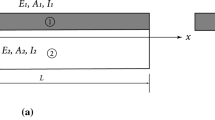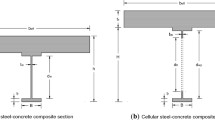Abstract
Stresses and deflections were measured in various semi-continuous composite beams. The bending and rotational capacities of the composite connections were measured in terms of beam curvatures and deflections by using two full-scale semi-rigid composite frames with monotonic loadings. The effect of semi-rigid connections on the performance of composite beams with various loadings was compared with predictions and codes. The tests show that the semi-continuous composite beams are more economic and effective than the simple or continuous composite beams. The semi-rigid connections affect the bending capacities and beam deflections, so the connection behavior should be considered in the design of composite beams. Yielding analysis of the steel beam bottom flange has some influence on the deflection calculation of composite beams.
Similar content being viewed by others
References
Nie Janguo. Experiment Theory and Application of Steel-Concrete Composite Beams. Beijing: Science Press, 2005 (in Chinese)
Wang Jingfeng. The practical design approach of semi-rigidly connected composite frames under vertical loads. Dissertation for the Doctoral Degree. Shanghai: Tongji University, 2005 (in Chinese)
Johnson R P, Anderson D. Designer’s Handbook Eurocode 4: Design of Composite Steel and Concrete Structures. London: British Standards Institution, 1994
BSI, BS5950. Structural Use of Steelwork in Building. Part 1: Code of Practice for Design of Simple and Continuous Construction. London: British Standards Institution, 2000
CEN, Eurocode 4. Design of Composite Steel and Concrete Structures. Part 1.1: General Rules and Rules for Buildings. ENV 1994-1-1. Brussels: European Committee for Standardization, 1993
GB50017. Code for Design of Steel Structures. Beijing: China Construction Industry Press, 2003 (in Chinese)
Kishi N, Chen W F. Moment-rotation relation of semi-rigid connections with angles. Journal of Structural Engineering, ASCE, 1990, 116(7): 1813–1834
Hensman J S, Nethercot D A. Numerical study of unbraced composite frames: generation of data to validate use of the wind moment method of design. J Construct Steel Res, 2001, 57(7): 791–809
Guo Bing. Seismic design of beam-column end-plate connections for steel frames. China Civil Engineering Journal, 2004, 37(11): 28–32 (in Chinese)
Shi Gang, Shi Yongjiu, Wang Yuanqing, et al. Experimental study of semi-rigid end-plate connections in multi-story steel frames. J Tsinghua University, 2003, 44(3): 391–394 (in Chinese)
Li T Q, Choo B S, Nethercot D A. Moment curvature relations for steel and composite beams. Steel Structures Journal of Singapore Structural Steel Society, 1993, 4(1): 35–51
JGJ82-91. Specification for Design, Construction and Inspection of High Strength Bolted Connections in Steel Structures. Beijing: China Construction Industry Press, 1992 (in Chinese)
Author information
Authors and Affiliations
Corresponding author
Additional information
__________
Translated from J Tsinghua Univ (Sci & Tech), 2007, 47(3): 313–318 [译自: 清华大学学报(自然科学版)]
Rights and permissions
About this article
Cite this article
Wang, J., Li, G. Bending and rotational behaviour of semi-continuous composite beams. Front. Archit. Civ. Eng. China 2, 116–122 (2008). https://doi.org/10.1007/s11709-008-0015-9
Published:
Issue Date:
DOI: https://doi.org/10.1007/s11709-008-0015-9




